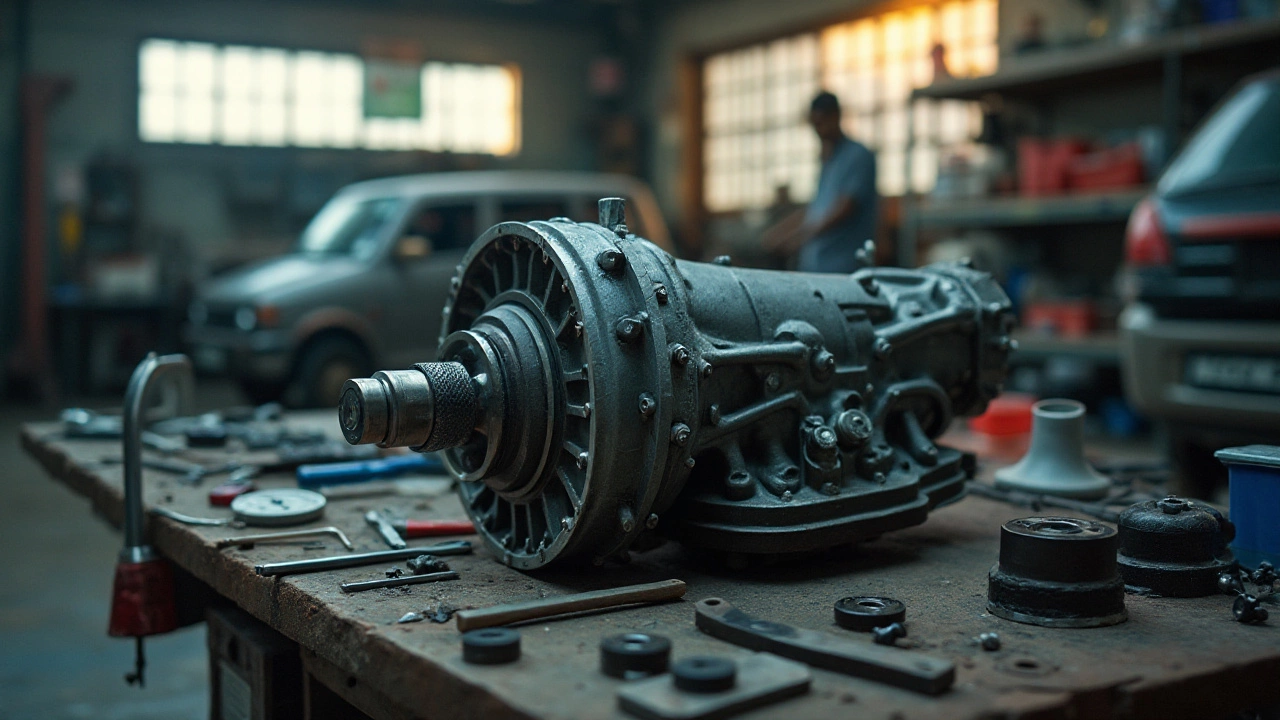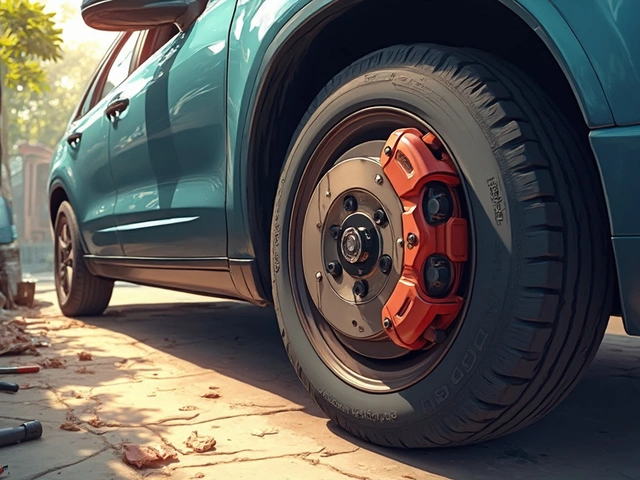Driving down the road, you notice a troubling sound—perhaps a grinding noise, or maybe a slipping sensation each time you shift gears. Your mind races: is it the clutch acting up, or is the transmission failing you? Both parts work tirelessly behind the scenes, yet when they falter, identifying which is to blame becomes essential.
The clutch and transmission are integral to your vehicle’s performance, and when issues arise, they bring inconvenience and concern. This article is here to guide you through the maze of symptoms and signs. With clear insights and practical advice, you can start understanding the root of the problem. Whether it's an aging clutch or a struggling transmission, we'll unravel the mystery so you can get back on the road, worry-free.
- Understanding the Clutch and Transmission
- Symptoms of Clutch Problems
- Signs of Transmission Failures
- DIY Diagnosis Tips and Maintenance
Understanding the Clutch and Transmission
When diving into the core components of your vehicle, the clutch and transmission often stand out for their fundamental roles in driving dynamics. At its heart, the clutch sits between the engine and transmission, bridging the power generated by the engine to the wheels. Its operation might seem simple – engaging and disengaging the engine's power – but without it, shifting gears smoothly would be near impossible. The importance of a healthy clutch becomes apparent the moment you begin to have difficulty changing gears or experience that telltale slipping sensation.
The transmission, on the other hand, is a marvel of mechanical engineering. This complex assembly houses gears and other components that allow your car to adapt its power delivery efficiently, providing both speed and torque as needed. Whether it’s an automatic or manual setup, the transmission ensures the right balance between engine speed and wheel speed, optimizing for different terrains and driving conditions. "The transmission is essentially the translator of engine power", remarks a prominent automotive engineer in an article from Car Mechanics Weekly. It translates the language of engine revolutions into the speed at which you drive.
The interplay between these two components doesn't stop at mere functionality. They work in tandem to not only ensure your car moves but does so in a reliable and efficient manner. While the clutch primarily deals with the manual transmission systems, automatic transmissions have a torque converter performing a similar role of transferring power. A common challenge faced by many drivers is differentiating between issues arising from the clutch versus those that come from the transmission itself. Understanding their individual function can significantly simplify the diagnostic process, helping you identify whether you need a simple clutch repair or more extensive transmission work.
Many car enthusiasts are familiar with the longevity and durability statistics associated with these components. While a typically well-maintained clutch lasts anywhere between 50,000 to 100,000 miles, a transmission might see much longer service life if properly cared for. Given the intricacies of their design and operation, a keen sense of their health is essential. Regular maintenance checks, listening for unusual noises, and feeling for irregularities in gear shifting are part of keeping these parts in top shape. To summarize, grasping the fundamental principles and operations of both the clutch and transmission equips you with the knowledge to tackle or preempt many vehicle issues.

Symptoms of Clutch Problems
When your vehicle's clutch starts to show signs of wear, it typically whispers—rather than shouts—its woes through subtle symptoms. Recognizing these early signals can prevent wrenching holes in your wallet later on. One of the most common indicators is a slipping clutch. You'll notice this when your engine races without a corresponding increase in speed, especially on an uphill road, as the clutch disc fails to engage the flywheel properly. The sensation is as though your vehicle wants to sprint but cannot find its footing. Another typical symptom is clutch chatter. This manifests not as a single thud but rather as a rapid sequence of vibrations when you attempt to disengage the clutch. If ignored, this can inhibit the smooth operation of your vehicle, making city driving feel like navigating a lunar rover over craters. Additionally, a dragging clutch can make gear shifts a struggle, often accompanied by a grinding noise, as the clutch fails to release fully. This peculiar sound warns you that the clutch isn't disengaging correctly, causing gears to clash at their side like two battling knights in a jousting match.
Pedal resistance—or lack thereof—provides another clue. If your clutch pedal feels unusually loose, it's not a sign of effortless driving, but likely an issue with the clutch linkage. On the other hand, a pedal that's hard to press often points towards a problem with the clutch hydraulics or cable. The feeling underfoot can often betray more than one imagines. Sometimes, even a foul smell akin to burning rubber can waft into the cabin, signaling friction struggles similar to an athlete’s sneakers skidding across a track at full speed. This is especially concerning if it happens repeatedly, indicating your clutch disc might be on its last stretch of durability. According to automotive expert John Smith,
"A failing clutch is much like a tired athlete; it starts small with tiny twinges until it simply can't go on anymore."Finally, listen to your vehicle when it's resting. Rattling noise during idling could be a loose clutch fork or similar component.
Each symptom is not just an inconvenience but rather a cautionary tale of what might unfold. Early action can save you from more extensive and expensive repairs. For instance, what's a minor slipping issue today could transform into a complete clutch assembly overhaul tomorrow. Paying attention to clutch problems is the kind of mechanical mindfulness that keeps your vehicle's heart beating strong and steady. Meanwhile, addressing these issues can be as simple as adjusting the clutch cable or fluid reservoirs, extending the lifespan of your clutch and preventing abrupt surprises when you're far from home. With knowledge in hand, you're better prepared to face these challenges confidently.

Signs of Transmission Failures
The transmission is the beating heart of your vehicle’s drivetrain, diligently converting the engine's output into usable power to rotate the wheels. When transmission issues occur, they can manifest in numerous ways, often leaving drivers confused and concerned. One of the most common signs of *transmission issues* is delayed or rough shifting. Imagine being stopped at a traffic light and noticing that your vehicle lurches or hesitates as you accelerate—this is a red flag waving directly from the transmission realm. Such vagrancy is often tied to worn-out components or insufficient transmission fluid, which sacrifices the lubrication and hydraulic power necessary for smooth operation.
Another telltale sign of a *transmission problem* is strange noises emanating from beneath the hood. If your car starts to sound like a coffee grinder on a Monday morning, it's time to pay attention. Such noises can indicate anything from low fluid levels to worn gears. It's essential to remember that healthy transmissions operate quietly, so any deviance points to trouble. A burning smell is another harbinger of transmission failure, often resulting from overheating components, which can occur if the *transmission fluid* is old or compromised. This smell is your car's way of pleading for immediate attention before severe damage sets in.
Strange behavior in the transmission can also project itself as harsh vibrations. You might feel a shudder or shake while cruising on highways or, at times, during low-speed maneuvers. These vibrations are symptomatic of various potential problems, ranging from an unbalanced drive shaft to worn-out transmission mounts. Additionally, a slipping transmission—where your vehicle seemingly changes gears at will, without driver input—is one of the more ominous signs that the transmission is struggling. Slipping not only affects drivability but can present safety risks if not addressed promptly.
Regular inspections and maintenance of your transmission can prevent or at least mitigate many of these frightful scenarios. Ensuring that the vehicle's transmission fluid is clean and at the appropriate level is fundamental. The state of the fluid can offer significant insights, as murky or burnt-smelling fluid is a symptom of poor health and needs replacement.
"Regular maintenance can extend the life of your transmission significantly," says John Mack, a renowned transmission specialist with over two decades of experience. "Ignoring early signs is like waiting for an engine to seize before you change the oil."For those keen on understanding their *vehicle diagnostics*, many newer cars offer self-diagnostic systems that aid in pinpointing the specific transmission issue, thereby saving time and potentially reducing repair costs.
If you're tech-savvy, you might consider investing in a quality OBD-II scanner. These tools can read transmission error codes, offering insights that can either confirm your suspicions or send you on a different diagnostic path. It's also wise to pay attention to fluid leakages, as low fluid levels often precipitate the symptoms discussed. Finally, if you're unsure, having a trusted mechanic evaluate your vehicle can help cut through the automotive noise, identifying the crux of the problem swiftly.

DIY Diagnosis Tips and Maintenance
Before you roll into the garage, there are a few steps that you can undertake in your driveway to determine whether your vehicle's troubles stem from the clutch or the transmission. It’s vital to first park your vehicle on a flat surface and ensure the engine is off and cool. Start by listening to each strange noise that accompanies your driving experience. A grinding noise when pressing the clutch pedal might indicate a worn clutch bearing or damaged pressure plate. Check how the clutch pedal feels under your foot: if it feels spongy or sinks without resistance, it might require adjustment or replacement of components. Don’t forget to look under the hood. A quick visual inspection of the clutch fluid reservoir will reveal if low fluid might be causing sluggish shift responses. As simple as these checks might seem, they provide a window into your clutch’s health.
Shifting our focus to the transmission, elaborate tests can pinpoint potential issues. Begin with verifying the transmission fluid level and condition. A low level or discolored, burnt-smelling fluid can spell trouble for the internal mechanisms. Look for any visible leaks below the gearbox, typically marked by reddish fluid stains on your driveway. Listen to the transmission at idle and while driving. Noisy operation or hard shifting can indicate severe problems within the gear system. Another test involves feeling how your vehicle behaves when engaging each gear. Hesitation or slippage under acceleration can signal an ailing transmission. These steps might reveal more information than meets the eye, saving you substantial time and money during professional repairs.
Being proactive extends to maintaining your vehicle to prevent these issues. Regular maintenance is integral to the longevity of both your clutch and transmission. Changes in transmission fluid, recommended roughly every 30,000 to 60,000 miles, keep things running smoothly. Pay attention to your driving habits; avoid aggressive gear changes and overheating the transmission with prolonged stop-and-go traffic drives. Additionally, replacing the clutch kit in due time will ensure your pedal remains responsive. Use a reputable repair manual or resource for guidance on these DIY measures. As Mark Nichol famously wrote,
"Maintenance is the heart of car care, much like how art needs understanding."This mantra underscores the balance between preventive check-ups and intricate knowledge of your vehicle's anatomy.
By understanding these diagnostics and maintenance practices, you can tackle minor issues before they escalate into expensive repairs. It's about giving your vehicle the attention it needs when it hints that something's awry. Next time your car behaves unexpectedly, have a checklist ready, and dive under the hood with a confident smile.




